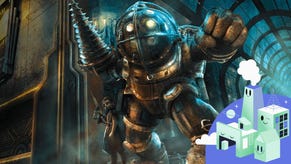Irrational reveals cut BioShock ideas
Insects! Pressure! Living machines! Nav-Bot!
Irrational Games has explained that the enemies of BioShock weren't always sentient humans; once upon a time the inhabitants of Rapture and holders of ADAM were insects.
"One of the original inspirations for BioShock was Ken Levine's belief that it was getting too hard to create meaningful human interactions in games. His first take on a solution: model meaningful insect interactions, like you would see on a nature show," said designer Alexx Kay on the Irrational Games website.
"BioShock would feature a complex ecology of creatures that interacted in simple, easy-to-get ways. Harvesters would gather resources and bring them back to Queens. Aggressors would attack the Harvesters, Protectors would guard them. (The Queens were large, immobile creatures, with lots of Adam, who could summon Protectors if attacked.) There would never be any speech, or any indication of higher intelligence.
"Ironically, we did a 180 from that," he added, "ending up with creatures that were very strongly human, if twisted, and who spoke all the time. Even the basic functionality of the ecology was mostly cut."
Even tape recorders were going to be "squishy, organic things", said Kay. "Machines that seemed mechanical on the surface would actually have mutated humans operating them behind the scenes - something that players would only come to realise partway through the game." The idea was that through the hacking mini-game you would increase ADAM flow to a mutated human machine and he'd respond by giving you items.
Irrational also revealed that BioShock had a clever atmospheric pressure system that was working at launch but never included. This meant each region could be pressure-regulated and changed between high, low and medium settings, and all AI was programmed to respond differently these; gaining different animations, vocalisations, appearances, speeds, vulnerabilities and damage bonuses.
"The system was originally designed so that the player had an additional way to manipulate the world to his advantage," said technical director Chris Kline. "For example, perhaps one AI was immune to fire in normal pressure but susceptible to it in high or low pressures; or an AI had poor perception in low pressure."
"In practice, the system was a disaster because it caused several gameplay and production issues." On top of all the different enemy behaviours, different light, fog and HDR setups needed doing for each region's pressure level. This tripled the amount of work, resulted in little control over the mood of a region - fog and lighting were out of the developer's hands - and meant QA teams testing every permutation of an enemy's behaviour.
"Most importantly - and this is the issue that put the nail in the system's coffin - was that we never found a good way to clearly convey the effect of pressure through audiovisual changes," added Klline.
He went on to say that remnants of this system can be found in Arcadia when the trees die and are then brought back to life.
And that's not all - BioShock was originally going to have a navigation bot to steer players around the world. A map was considered too costly in terms of time and resources, so a Nav-Bot was constructed that could be summoned at the press of a button and programmed to head to a set of destinations on a 2D user interface.
"There were a number of problems with this concept," explained Kline. "The biggest one was that, while following Nav-Bot, the player would spend the entire time looking at the floor as Nav-Bot shuttled along (I pitched him as something akin to K-9 from Dr. Who)." Other concerns were players getting distracted and losing the bot, the Nav-Bot getting stuck during battle, the Nav-Bot having no legs to get up stairs and the conundrum of how to 'mark' a location to go back to.
"Another hurdle to overcome was the fact that, unlike maps, Nav-Bot was not a familiar concept in first-person shooters. In the end, someone (maybe Jon Chey at Irrational Games Australia) made the executive decision that we needed to suck up the extra work and make a map. Thus died Nav-Bot," said Kline.
Irrational Games' "5 Cut Features" also explains that in System Shock 2 there was very nearly a log explaining why weapons degraded over use. "Of course, in hindsight, the team has been kicking themselves for not including that audio log. In one fell 30-second swoop, we could have prevented about 80 per cent of the complaints, or at least redirected them toward Xerxes and the Many, and away from the development team," said designer Dorian Hart.









